On 4 September, Newcastle City Council published a planning application to build on South Gosforth Green. This application, made on behalf of the Council’s Fairer Housing Unit, is for 7 bungalows in a courtyard arrangement with parking and an access road from Ridgewood Gardens to the north.
The facilities proposed, to support people with physical disabilities and those with learning disabilities and/or autism, are undoubtedly a good thing. On the other hand, if approved, this development will lead to the irreversible loss of part of the green currently available and of benefit to the wider community. So while we support the creation of such a facility we do have concerns about the use of this location and the precedent this may set to allow building on other green space.
The benefits of having good quality green spaces within cities are well known. The National Trust, who are working with Newcastle City Council on its proposed Parks Charitable Trust have estimated for Sheffield that its parks and green spaces are an asset worth £1.2bn to the city including their very positive impact on physical and mental health for residents. Newcastle Council’s strategic objectives recognise this and include an objective to “Improve the function, usability and provision of our green infrastructure and public spaces by providing a network of green spaces and features which are connected and accessible for all.”
Recent history however suggests this objective to improve the provision of green space is no longer being pursued. In February the Council approved an application to build on Montagu Green in Kenton and in April we found the green in Grange where Alan Shearer learned to play football had also been earmarked for housing.
This raises a whole range of questions. Why has the Council chosen to build on community green space? How will the value of the new facility be weighed against the loss of green spaces? What criteria will be used to judge this and is the application compliant with these criteria? What happens when the Council is acting both as a developer and also as the planning authority? And what does this mean for the future of other green spaces in Gosforth and across the city? We thought we better have a look.
Why has the Council chosen to build on community green space?
The National Planning Policy Framework (paragraph 47) requires Councils to assess future housing needs and, where additional housing is required, identify sites that can be developed to meet those needs. For new housing to be developed in the next five years those sites must be immediately available, suitable for development and with a realistic prospect that housing will be built within the five year period. Given such criteria, parks and green spaces owned by the Council (or any Council) are going to be attractive targets if not given suitable protection.
That said, the most recently published assessment for Newcastle, set out in the draft 2016 Housing and Economic Land Availability Assessment (HELAA) and summarised in the interactive map below, does not include South Gosforth Green, nor the Park Avenue green. The Valley, by Newlands Road in High West Jesmond, is mentioned but as a site that has been specifically discounted, as is the former Sanderson Hospital site in West Gosforth.
Although not in the current site list for future housing, South Gosforth Green was in included in the Council’s 2013 Strategic Land Housing Availability Assessment. In this assessment it was recorded that this location would be “most suitable for development of a bungalow court” but that there was “no Council resolution to dispose of site for residential development” and that the main constraint to housing development there was the Council’s own Open Spaces policy.
While none of this would constrain a private developer from submitting a planning application for South Gosforth Green, it does seem surprising that the Council itself should choose a location it has specifically removed from its own development list and where previously it has noted non-compliance with its own policies. In these circumstances it seems reasonable to ask why the Council has submitted an application given its own plan shows sufficient sites for building without the loss of this green space.
How will the value of the new facility be weighed against the loss of green spaces?
Section 38(6) of the Planning and Compulsory Purchase Act 2004 requires that applications for planning permission must be determined in accordance with the Council’s statutory development plan unless material considerations indicate otherwise. The statuatory development plan for Newcastle consists of the Core Strategy and Urban Core Plan for Gateshead and Newcastle upon Tyne 2010-2030 and a number of reserved policies from the previous Unitary Development Plan including a number of policies relating to the protection of open spaces.
The Planning Statement prepared by the developer effectively admits that the proposed development is not in line with the development plan saying “it would still be difficult to justify development against UDP Policy OS1.5“. Policy OS1.5 along with OS1.4 are the key policies protecting open spaces. Policy OS1.5 sets a strong presumption against building on open spaces and lists four “exceptional circumstances”, none of which apply to the South Gosforth Green application. These four exceptional circumstances are the only circumstances where loss of open space would be considered acceptable according to the plan.
This does not automatically mean that the proposal will be rejected though. The approved application for Montagu Green was also assessed to be not in accordance with the development plan. The planning officer report (paragraph 108) stated that “none of the exceptional circumstances listed in policy OS1.5 are considered applicable in this case. As such, the proposal is a departure from the development plan.”
The Montagu report then goes on to say: “As such, consideration is required as to whether the loss of the open space would be outweighed by the benefits of the proposed development.” In effect, this reasoning appears to be second guessing the development plan as the development plan has already set out very clearly (in policy OS1.5) the specific circumstances in which the benefits of the proposed development should outweigh the loss of green space. Based on this, it feels quite likely that the recommendation given to the Planning Committee to approve the Montagu Green application was incorrect.
The South Gosforth application also states that “A separate ‘Open Space Assessment’ has been prepared which concludes that the development of the site for housing, would not result in overriding harm in terms of loss of open space functionality.” This conclusion also appears to be unjustifiable as Policy OS1.4 defines that “Harm includes loss of the space in whole or part.” and that “development which would cause demonstrable harm to any public open space… will not be allowed.” (underlined for emphasis). This same was true for Montagu Green however and that was recommended for approval despite the very clear harm (as defined by policy OS1.4) caused by loss of part of the green.
What criteria will be used to judge this and is the application compliant with these criteria?
As set out above, the South Gosforth application is not compliant with the local development plan and, if there are no material considerations to the contrary, should be rejected as required by the Planning and Compulsory Purchase Act.
Material considerations could include loss of privacy, traffic issues, lack of sufficient local facilities e.g. school places, impact on nature or layout and density of the design. Some of these aspects we wrote about in relation to a planning application at Gosforth Business Park and are for the most part reasons to reject an application rather than to approve a non-compliant application.
The National Planning Policy Framework is also considered to be a material consideration and the South Gosforth Application references paragraph 74 which also states a presumption against development on open space but in addition to the circumstances set out in policy OS1.5 also allows open space to be built on if “An assessment has been undertaken which has clearly shown the open space, buildings and land to be surplus to requirements.”
This circumstance is not included as an option in the development plan however policies OS1.4 and OS1.5 in effect confirm that the open spaces listed (including South Gosforth Green and Montagu Green) are (or were) required and are therefore not surplus to requirement.
The Open Spaces Assessment included in the planning application suggests an alternative view with a set of minimum “quality” standards that allow for the removal of green space even though Council strategic objectives and detail policy at the time of the application suggest this should not happen.
This leads to the following comparison of current green space vs the ‘quality standard’ which the developer asserts (we believe incorrectly) “clearly shows” the part of South Gosforth Green that is to be developed “to be surplus to requirements”. (quoted words from National Planning Policy Framework paragraph 74).
Based on the proposed Draft Development and Allocations Plan on the agenda for Council Cabinet on 18 September 2017 (table 1 p67), the Amenity Green Space ratio will be 1.0ha/1000 rather than 0.8ha/1000 stated above. This increases the requirement from 8.11ha to 10.14ha and reduces the surplus to only 0.15ha so far less than the 0.44ha site covered by the application. If this application is approved then it will cause East Gosforth ward to be in shortfall for Amenity Green Space even with the new lower standards. These new ratios will not apply however until after public consultation which, if approved by Council Cabinet. will not complete until December 2017.
Measured against current policy the application is even less compliant. Policy OS1.2 states that when considering planning applications the appropriate measures are (a) that most households should be within 500m of a public park of 6 hectares minimum (not met at South Gosforth Green); and (b) rates for local open spaces and spaces for outdoor sport set at 1.2 ha/1000 people and 1.1 ha/1000 people respectively (much higher than is available at South Gosforth Green).
There are a number of further issues with this assessment beyond the fact that it doesn’t appear to comply with Council policies or objectives.
- The developer cites the “over-provision” of Amenity Green Space as a reason for allowing the development to go ahead. While this is mathematically true based on the ratios provided with the application and for that specific category, if this assessment is made in respect of overall green space excluding allotments (i.e. locations where children can play) then even against these lower standards there is currently an under provision of 2.7 hectares, which will be made worse by this proposal.
- The assessment states that Gosforth Central Park and Paddy Freemans are within a 15 minute walk of South Gosforth Green. While this may be true for a fit adult, the actual access standard is 720m which is not met as Gosforth Central Park is approximately 900m (see map below) and Paddy Freeman even further.
- Walking routes to both these parks require the use of and crossing of busy main roads including Haddricks Mill roundabout, which according to analysis by The Chronicle is one of the 10 most dangerous roundabouts in Britain.
- Just taking the distance from South Gosforth Green is too simplistic an analysis to judge distance as the 900m / 1100m would be incremental distance for anyone living north of South Gosforth green, in particular in Garden Village where contrary to its name there is a lack of usable open space.
- The assessment scope covers the area enclosed by East Gosforth ward whereas people do not stick to political wards when choosing which park to go to. In this case, a large part of the Amenity Green Space for this ward is at the other end of the ward on the Little Moor, 1400m away.
- Even if the 720m threshold was met, this doesn’t mean that children from South Gosforth would go (or be allowed to go) to these other parks. As a 2010 study observed “The distance our kids stray from home on their own has shrunk by 90% since the 70s; 43% of adults think a child shouldn’t play outdoors unsupervised until the age of 14“. So even if children don’t miss out as a result of this application it would create a significant additional time burden on parents escorting them to parks, where previously they did not need to. This is particularly important in light of the observation in the local development plan that Newcastle is “losing families and employed people to other districts.“
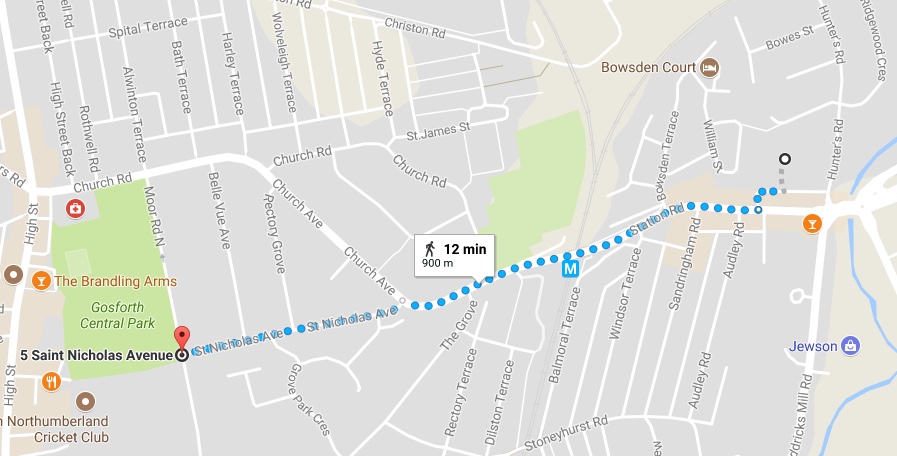
Google Maps walking directions from South Gosforth Green to Gosforth Central Park. According to the application 720m is the maximum distance anyone should have to walk to a park. Click to go to Google Maps directions.
What happens when the Council is acting both as a developer and also as the planning authority?
This application has also highlighted a number of issues with the planning process itself.
- The Council is acting in multiple roles which potentially conflict. As well as being the developer making the application, it is also the planning authority that assesses the application and the policy-setting body that creates the policy that the application will be assessed against.
- The developer has been given access to unpublished (and possibly unapproved) Council Open Spaces Needs Assessment, which suggests the planning department may have had a significant part in writing this key aspect of the application. This means in the final assessment the planning department could in effect be marking its own homework and potentially may not apply the proper scrutiny it deserves.
- As developer, the Council appears to be over-relying on its role in policy-setting to interpret local plan policies in a way that may not have been intended when those policies were made. Updating the Open Spaces Needs Assessment to vary the quality standards for open spaces could be seen in a similar light, as could an over-reliance on ward boundaries for assessing open space availability.
- A similar potential conflict also exists for the Councillors that attend the Planning Committee, in that they are being asked to review their colleague’s application.
- From a financial perspective, a further conflict exists in that if there is to be a developer contribution it would have to be paid by the Council. In the planning application it states “There is no scope, nor any requirement, for the development to make wider planning contributions.” despite the loss of community green space. The National Planning Policy Framework (paragraph 204), on the other hand, states that planning obligations (including financial payments) may be sought in order to make the proposed development acceptable in planning terms. In this case that would be (as per policy OS1.5) the cost for the Council of providing an alternative of equivalent community benefit, which could be considerable.
- There are also financial questions regarding future ownership of land e.g. will it be sold to Your Homes Newcastle and if so will the Council recover a fair market price for the land. Arguably, if this application goes ahead, any monies resulting from that sale should go to benefit the community that has lost the benefit of the green in addition to the developer contribution.
What does this mean for the future of other green spaces in Gosforth and across the city?
Parks and green spaces in Newcastle and in local authorities across the country face an uncertain future. When Council budgets are being cut then non-statuatory services such as parks will inevitably be affected.
At the same time cities across the world are striving to find ways to create more green space as they both understand the value to its residents and in attracting people, especially families, to come and live and work there. These include cities like Barcelona looking to double the number of trees and increase park space by two thirds , like Seoul where a highway has been turned into a public park and New York where the High Line park has been created from a former elevated freight rail line.
The applications at Montagu Green and South Gosforth Green should be a wake up call to anyone who values parks and green spaces in the city. By the time a planning application has been submitted it may well be too late. In many cases there will be friends groups already formed to look after parks that you can join and support, but if there isn’t it is never too late to start one. Whatever ratios are used to calculate under or over provision, green spaces that are cared for and well used by the local community will have a much better chance of survival than those that are not.
Comments on the South Gosforth Green planning application need to be received by 25 September 2017. There is also a Community Picnic planned on South Gosforth Green on 23 September.
The new reduced Open Spaces ratios proposed in the Development and Allocations Plan is due to be consulted on between 9 October 2017 and 20 November 2017.
UPDATE 28/9/2017
We wrote to the Council about the potential conflicts of interest referenced above. Whilst the developer clearly had access to documentation that has only just been made publicly available, we do have confirmation that “the application was prepared by the Fairer Housing unit and did not have any involvement from officers in Development Management.”
The Council have also confirmed that “All applications need to be fully assessed against the adopted policies at the time of determination of the application. All emerging policy are a material consideration and the weight to be applied depends to some degree on the stage of consultation.” We understand this to mean that the proposed lower levels of protection for open space can be taken into account in the assessment made by the Planning Officer but that these should be given lower weight as they have not yet been consulted on.
We also have confirmed that this will be taken to Planning Committee rather than to be made via a delegated decision. Agendas and papers for Planning Committees are available here. The next committee is planned for 13 October 2017.
In addition, the evidence base for the DAP is now available to view, which includes reference to the Newcastle Open Space Assessment 2016-2030 referred to in the planning application.
The Open Space Assessment states a ratio of 0.8ha/1000 people (section 6.3), which might explain why the planning application uses this figure rather than 1.0ha/1000people set out in the DAP. The DAP however is the definitive policy document approved by cabinet to be consulted on and which could be cited as a material consideration (albeit of lower weight) for this application.
Based on figures set out in the Open Space Assessment there are 10,145 people in East Gosforth (section 1.4.3) and so based on 1.0ha per 1000 people there needs to be 10.15 ha of Amenity Green Space in East Gosforth ward.
Table 7 (section 5.2.2) of the Open Space Assessment says that there are currently 10.28 ha of Amenity Green space in East Gosforth so, under the yet to be consulted on ratios, a “surplus” of 0.13ha which means if the application was to go ahead it would result in a deficiency of 0.31ha in the ward and would not be compliant with the proposed new open spaces policy (Policy DM29 – see below). This confirms the analysis made in the original blog post.
UPDATE 7/10/2017 Planning Committee Report recommends approval
The Council has published its Committee Report and has confirmed this application will be on the agenda for the Planning Committee on Friday 13th October.
The Committee Report confirms that, as we outlined above, the application does not comply with UDP Policies OS1.4 and OS1.5 relating to Open Space provision [See References D below] and does not comply with Core Strategy Policy CS18 “Green Infrastructure and the Natural Environment” that requires open space to be protected and enhanced in accordance with agreed standards in line with national policy.
It also confirms that the application does not comply with NPPF paragraph 74 [See References B below] which sets out national standards for whether open spaces can be built on. Paragraph 74 could have applied in this case if an assessment had shown the open space to be clearly surplus to requirements but this has not happened.
With regard to the proposed Draft Development and Allocation Plan, which proposes to reduce open space protections for the city and which the developer appeared to be relying upon to suggest there was a surplus of open space in the East Gosforth ward, the report confirms that this has limited weight as it has not yet been through any public consultation. This is not mentioned in the conclusion and we therefore assume it was not a factor in the officer’s recommendation.
The purpose of the proposal, for affordable bungalows for people with support needs, is considered to be a material consideration in favour of the application. To quote the report “There is a lack of affordable housing in the area and the proposal would only build on a third of the area of open space.”
Paragraph 54 expands on this to say that “East Gosforth and the surrounding wards (West Gosforth, Parklands, Dene and North Jesmond) have the lowest supply of affordable housing in Newcastle at only 7%. The City average is 30% of the housing stock being affordable housing. Only 6 affordable house have been completed in these wards in the past 25 years (with none in the East Gosforth Ward).”
East Gosforth, and the other wards mentioned, also have some of the lowest proportions of parks & amenity green space in the city at 1.26ha/1000 people compared to a city-wide average of 1.65ha/1000 people. [Figures calculated from the Council’s Open Space Assessment.]
The recommendation to the Planning Committee is that the committee should approve the application subject to conditions that include:
- Investigation of potential contamination and in respect of mining works.
- Implementation of open space enhancement works.
- Tree protection measures
- Provision of bat and bird boxes.
- Affordable housing only.
There is no planning condition in relation to the purpose of the housing to assist people with support needs.
The Planning Committee will have to assess whether it supports this recommendation to prioritise the benefits of building affordable housing in this location over Council and National policy to protect green spaces from over-development.
If approved by the Planning Committee, details relating to appearance, landscaping, layout and scale will be considered once the developer has submitted a further application to confirm these elements.
UPDATE 15/11/2017
The Planning Committee approved the application at the 3 November meeting and the decision notice has now been uploaded to the planning website.
There are sixteen conditions associated with the approval. Most of these are generic e.g. to do with ensuring the final proposal (the “reserved matters” application) meets road design and environmental standards. Conditions specific to the final proposal include:
- There needs to be “Investigation and Risk Assessment to assess the nature and extent of any contamination on the site”.
- There needs to be “A scheme of intrusive site investigations for the shallow coal workings.”
- There needs to be “a detailed scheme of enhancements of the retained area of open space abutting the southern and western boundaries.”
- The proposal needs to include “details of bird and bat boxes”
- “The development shall provide 100% affordable housing for and the dwellings shall meet the definition of affordable housing.” There is an accompanying note to say these are to be affordable housing for older people.
In the original application it stated that The facilities proposed were to support people with physical disabilities and those with learning disabilities and/or autism so the purpose of the housing appears to have changed.
REFERENCES
(A) Planning Applications
South Gosforth Green
- Save South Gosforth Green Facebook group
- Save South Gosforth Green Twitter account
- Planning Application – comments due by 25 September 2017
Montagu Green, Kenton – decided 3 February 2017
- Save our green – Montagu Estate Facebook group
- Planning Application and decision
- Planning Committee officer report and decision – see item 7
- The local battle which exposed the war against Britain’s green space – article in The Spectator Magazine about Montagu Green
(B) Planning Policy and the Local Development Plan
Newcastle City Council’s Local Plan (the Statutory Development Plan)
- Proposed Local Development Plan for 2017-2020 (item 3.2 Council Cabinet 18/9/17)
- Proposed Draft Development and Allocation Plan (Item 3 Council Cabinet 18/9/17) – includes updates to Open Space policies.
- Core Strategy and Urban Core Plan for Gateshead and Newcastle upon Tyne 2010-2030
- Unitary Development Plan – applies where policies (including relating to Open Spaces) have been reserved. (see below for Open Space Policies).
- Summary of policies relating to planning.
- Evidence base for the Development and Allocations Plan.
- Newcastle Open Space Assessment 2016-2030
Housing Needs Assessments for Newcastle upon Tyne
- The draft 2016 Housing and Economic Land Availability Assessment (HELAA). No final version has been published to our knowledge.
- Strategic Housing Land Availability Assessment 2013
Open Spaces Needs Assessments and related documents
- Policy OS1.2 (see copy below) sets out planning standards for how much open space is required as part of and as a result of planning applications.
- Planning Obligations Supplementary Planning Documentation 2016 (confirms OS1.2 still applies)
- Green Infrastructure Study – Evidence Base 2011
- Public Green Space, Sport and Recreation – Needs and Opportunities 2009
- Green spaces … using planning 2004
- The most recent draft Open Spaces Needs Assessment referred to in the application has not been released to the public. We requested this on 29 August and were told that this is part of a set of documents to be reviewed by Council Cabinet on 18 September.
National Planning Policy
- The National Planning Policy Framework Paragraph 74 refers to conditions for building on open spaces.
Proposed Open Spaces Policy as part of the DAP
Proposed DAP Policy DM29 – Protecting Open Space
- Redevelopment of open space, sports, recreational buildings and land, including playing fields will only be allowed where an assessment has been undertaken in accordance with the Council’s open space standards which demonstrates:
- there is a proven surplus of such provision and the proposed loss will not result in a current or likely shortfall in the plan period; or
- any loss resulting from development will be replaced by the equivalent or better provision in terms of both quality and quantity in a suitable location; or
- the development proposed is for alternative sports and recreation provision or green infrastructure, the need of which clearly outweighs the loss of the existing open space.
2. Development which would result in the loss of open space not shown on the Policies Map that contribute to the character and visual amenity of an area will not be permitted unless it can be demonstrated that the benefits of development clearly outweigh the loss.
3. Development of ancillary facilities on open space will be supported where:
- it is necessary to or would facilitate the functioning of the open space;
- it would be appropriate in scale;
- it would not detract from the character of the site or surroundings;
- it would not be detrimental to any other function that the open space performs; and
- it would contribute positively to the setting and quality of the open space.
(C) Proposals for a new Newcastle Parks Charitable Trust
- Development of a Charitable Trust to Deliver Newcastle’s Parks and Open Spaces (see item 4). Note that South Gosforth Green is not currently included in the scope of this Charitable Trust.
Local park community groups include:
- Friends of Gosforth Central Park Facebook, Twitter.
- Friends of Havannah Facebook, Twitter.
- Exhibition and Brandling Park Community Trust Facebook, Twitter
- Friends of Leazes Park Facebook.
- Friends of Walker Park Facebook.
- Friends of Iris Brickfield Facebook, Twitter.
- Heaton and Armstrong Parks Facebook, Twitter.
- Greening Wingrove Facebook, Twitter.
- Friends of Jesmond Dene Facebook.
- Friends of Summerhill / Summerhill Bowling Club Facebook, Twitter.
- Scotswood Garden Twitter.
- Newcastle Parks Forum Facebook.
- Parks for People Gosforth Facebook, Twitter.
- Friends of the Valley and Little Dene (FOVALD) Website.
(D) Open Space Policies from the Unified Development Plan
OS1 THE BEST POSSIBLE STANDARDS IN THE RANGE, AMOUNT, DISTRIBUTION, ACCESSIBILITY AND QUALITY OF OPEN SPACE WILL BE SOUGHT THROUGHOUT THE CITY BY:
- A. PREVENTING THE LOSS OF OPEN SPACE TO DEVELOPMENT;
- B. MAINTAINING AND IMPROVING EXISTING OPEN SPACE;
- C. CREATING NEW OPEN SPACE WHERE OPPORTUNITIES OCCUR AND IN ASSOCIATION WITH NEW DEVELOPMENT;
- D. PROMOTING RECREATION IN THE COUNTRYSIDE THROUGH SCHEMES FOR ENVIRONMENTAL IMPROVEMENT, PUBLIC ACCESS, AND APPROPRIATE FACILITIES; AND
- E. PURSUING PROVISION FOR ALL NEEDS IN THE COMMUNITY, INCLUDING THOSE OF CHILDREN, THE ELDERLY, AND PEOPLE WITH DISABILITIES.
OS1.1 DEVELOPERS WILL BE REQUIRED TO PROVIDE OPEN SPACE IN ASSOCIATION WITH HOUSING DEVELOPMENT AND MAJOR DEVELOPMENTS FOR OTHER LAND USES.
OS1.2 IN THE DETERMINATION OF PLANNING APPLICATIONS FOR RESIDENTIAL DEVELOPMENT, THE COUNCIL WILL HAVE REGARD TO THE FOLLOWING STANDARDS IN ASSESSING THE APPROPRIATE AMOUNT AND DISTRIBUTION OF OPEN SPACE REQUIRED AS PART OF, AND AS A RESULT OF, THE PROPOSALS:
- A. NEIGHBOURHOOD AND CITY CENTRE PARKS – SUBSTANTIAL PUBLIC SPACES PROVIDING FOR A RANGE OF ACTIVE AND PASSIVE PURSUITS FOR PEOPLE OF ALL AGES AND ABILITIES. MOST HOUSEHOLDS SHOULD BE WITHIN 0.5 KM OF A PUBLIC PARK OF 6 HECTARES MINIMUM;
- LOCAL OPEN SPACES – 1.2 HECTARES FOR 1,000 PERSONS;
- SPACES FOR OUTDOOR SPORT – PROVIDING FACILITIES FOR INDIVIDUAL PARTICIPATION IN SPORT AS WELL AS FOR ORGANISED TEAM GAMES – 1.1 HECTARES PER 1,000 POPULATION, INCLUDING EDUCATION FACILITIES USED BY THE PUBLIC;
- OTHER SPECIALIST RECREATION FACILITIES – SPACES PROVIDING OPPORTUNITIES FOR HORTICULTURE AND KEEPING ANIMALS, E.G. ALLOTMENTS AND STABLES -– ALLOTMENT PLOTS SHOULD BE AVAILABLE FOR APPROXIMATELY 5% OF THE POPULATION OF 30-75 YEARS; AND
- THE AVAILABILITY OF AREAS OF NATURE CONSERVATION VALUE, COUNTRYSIDE CHARACTER, COMMUNITY WOODLAND OR COUNTRY PARKS WHICH CAN PROVIDE FOR A WIDE RANGE OF PASSIVE RECREATIONAL ACTIVITY.
OS1.4 DEVELOPMENT WHICH WOULD CAUSE DEMONSTRABLE HARM TO ANY PUBLIC OPEN SPACE, OR PRIVATE OPEN SPACE FOR OUTDOOR SPORT, WILL NOT BE ALLOWED. HARM INCLUDES LOSS OF THE SPACE IN WHOLE OR PART. DEVELOPMENT, THEREFORE WILL ONLY BE ALLOWED IN EXCEPTIONAL CIRCUMSTANCES IN ACCORDANCE WITH POLICY OS1.5. HARM WILL BE ASSESSED ACCORDING TO THE IMPACT ON THE VALUE, ACTUAL OR POTENTIAL, OF THE OPEN SPACE FOR ANY ONE OR MORE OF THE FOLLOWING PURPOSES:
- INCLUSION WITHIN A GREEN WEDGE LINKED TO THE COUNTRYSIDE OR LAND OF COUNTRYSIDE CHARACTER WITHIN THE URBAN AREA;
- PROVISION FOR PARTICULAR SPORT OR OTHER ORGANISED RECREATIONAL ACTIVITY;
- PROVISION FOR INFORMAL OR CASUAL RECREATION, INCLUDING CHILDREN’S PLAY AND RECREATIONAL ROUTES;
- PROVISION FOR HORTICULTURAL OR OTHER SIMILAR SPECIALISED RECREATION SUCH AS ALLOTMENTS AND PIGEON CREES;
- OPENNESS AND/OR GREENERY PROVIDING VISUAL RELIEF IN A BUILT-UP AREA;
- CONTRIBUTION TO THE AMENITY OF A LOCALITY; OR
- PRESERVATION OF A WILDLIFE HABITAT OR CONTINUITY OF A WILDLIFE CORRIDOR.
OS1.5 DEVELOPMENT AFFECTING AN OPEN SPACE SUBJECT TO POLICY OS1.4 [which includes South Gosforth Green] MAY ONLY BE ALLOWED IF ANY OF THE FOLLOWING EXCEPTIONAL CIRCUMSTANCES APPLY:
- A. IT IS FOR RECREATIONAL PURPOSES RELEVANT TO THE USE OF THE SPACE; OR
- IT IS FOR NEW OR IMPROVED ESSENTIAL LOCAL COMMUNITY FACILITIES FOR WHICH THERE IS NO SUITABLE ALTERNATIVE SITE; OR
- THE ONLY MEANS OF RETAINING OR ENHANCING THE OPEN SPACE IS THROUGH DEVELOPMENT OF A SMALL PART; OR
- ALTERNATIVE PROVISION OF EQUIVALENT COMMUNITY BENEFIT IS MADE AVAILABLE.

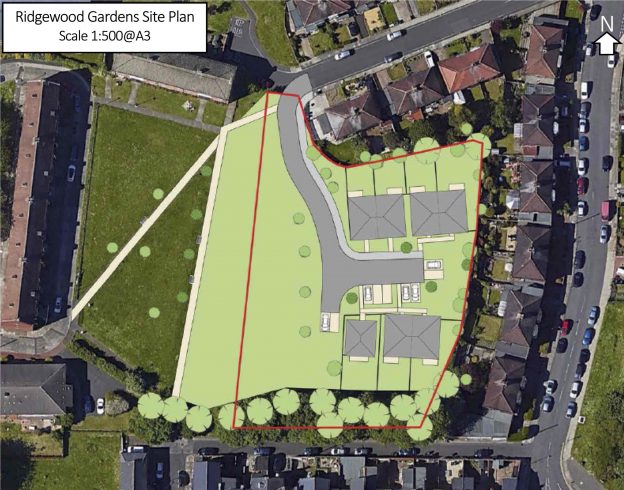
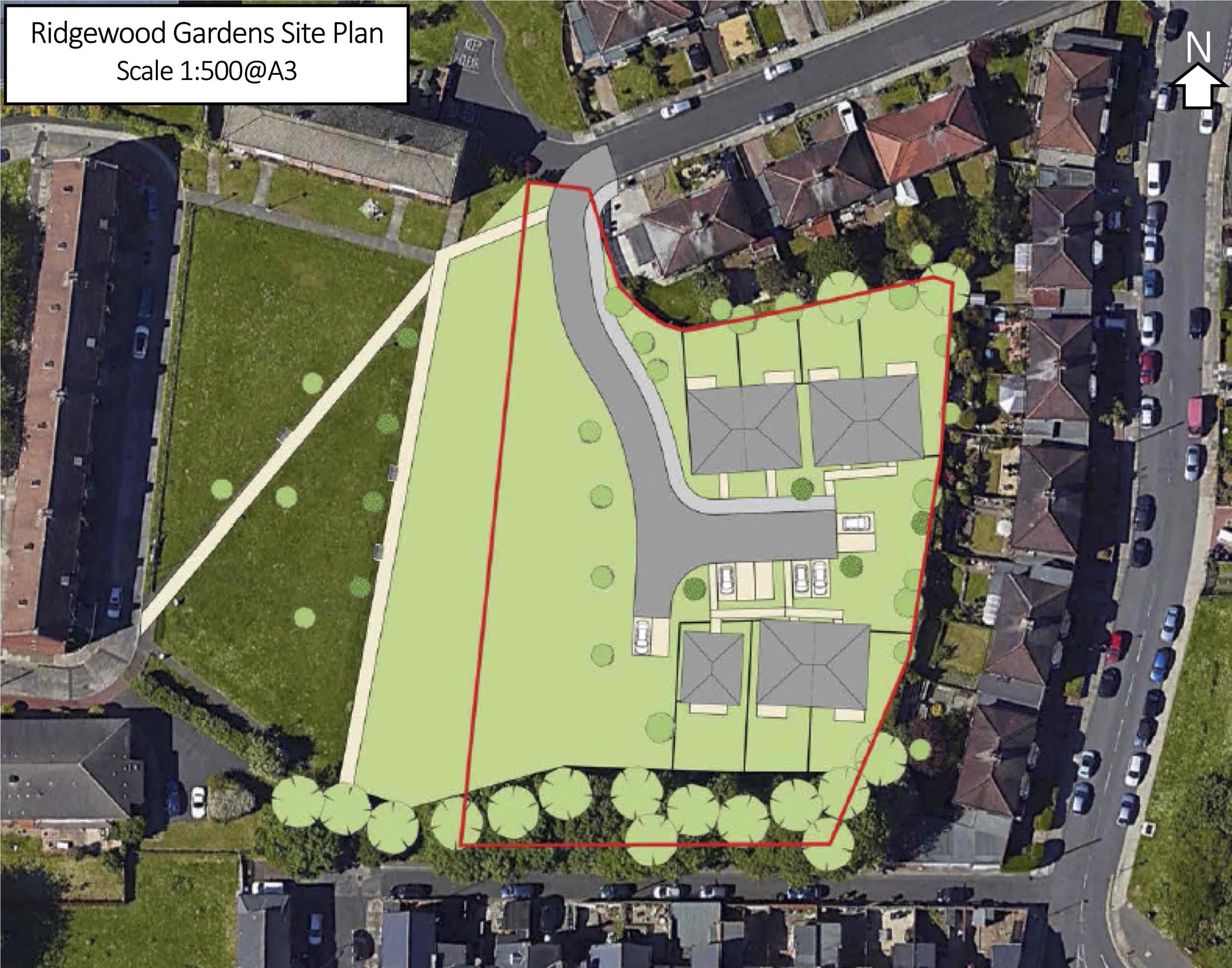
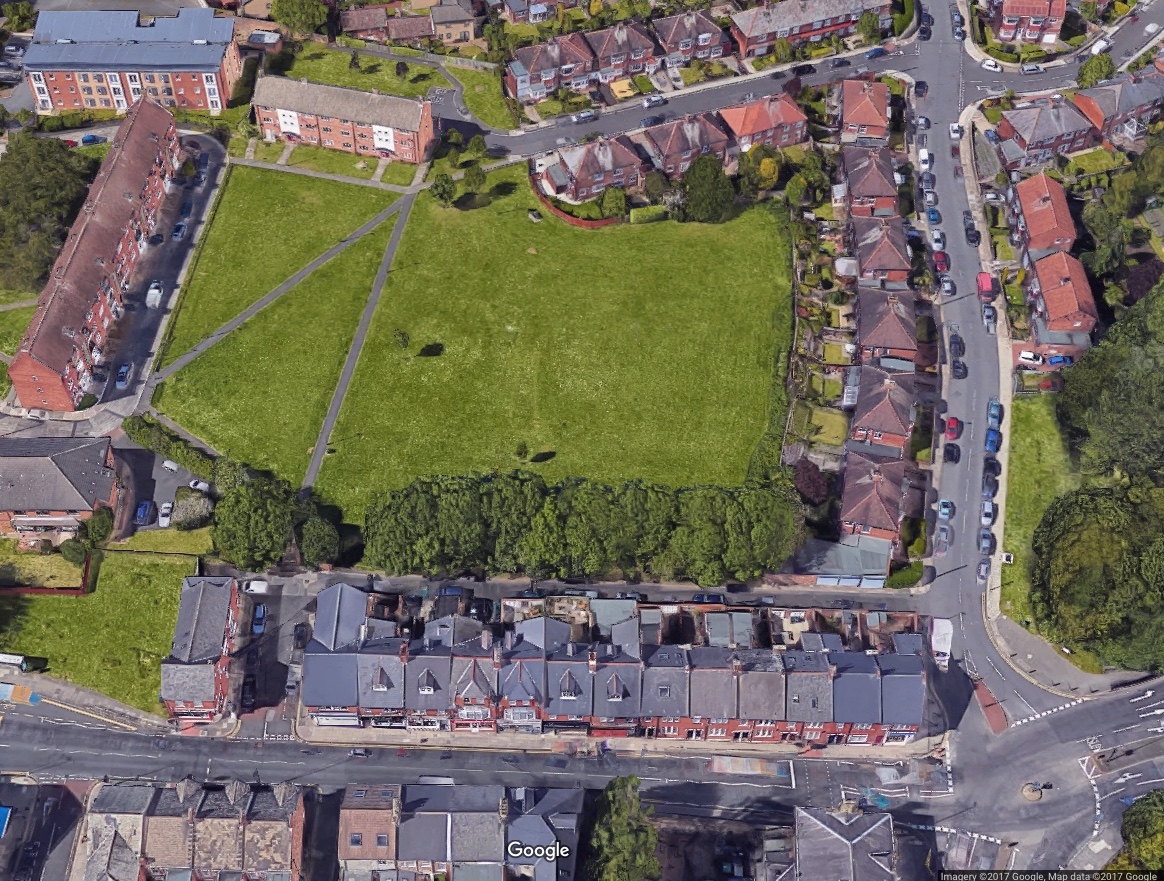
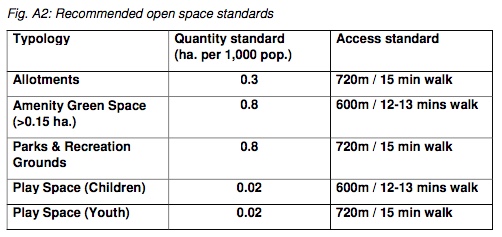
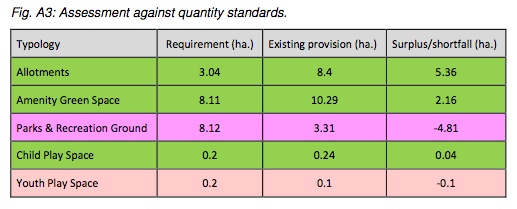
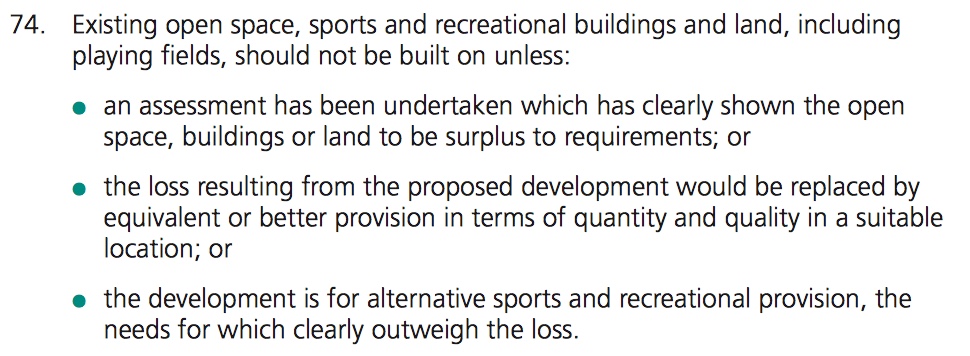
Update from Newcastle Chronicle 8 July 2018.
Decision time for development plan that could ‘destroy’ South Gosforth Green
https://www.chroniclelive.co.uk/news/north-east-news/decision-time-development-plan-could-14876405
Update from Newcastle Chronicle 13 July 2018.
Controversial plans to build bungalows on South Gosforth Green have been approved
https://www.chroniclelive.co.uk/news/north-east-news/controversial-plans-build-bungalows-south-14907278
Deputy council leader, Coun Joyce McCarty, said: “People with disabilities have a right to live in nice places too and there’s a chronic shortage of supported housing in this part of Gosforth.
“I recognise that some residents are concerned that the loss of open space. We have worked hard to ensure that the loss of the green space is kept to a minimum and the additional landscaping will significantly improve the remaining open space making it a much more pleasant area to use, sit and enjoy.”